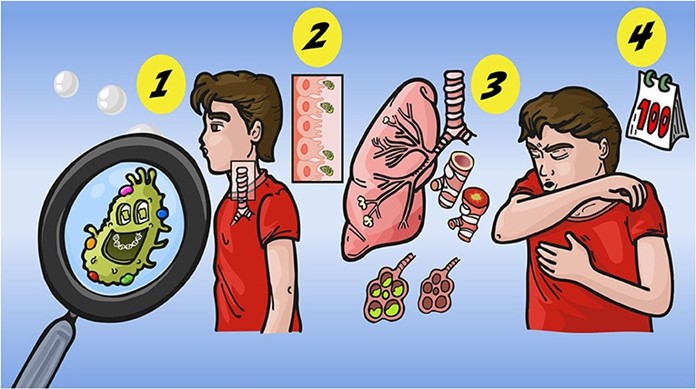A nurse is caring for a child who has pertussis. The child's parent asks the nurse what the common name for this disease is. The nurse should respond with which of the following common names?
Mumps
Whooping cough
Fifth disease
Chickenpox
The Correct Answer is B
Choice A reason: This choice is incorrect because mumps is not the common name for pertussis. Mumps is a viral infection that causes inflammation of the salivary glands, especially the parotid glands. It may cause symptoms such as fever, headache, and swelling of the cheeks or jaw. It can be prevented by vaccination with the measles-mumps-rubella (MMR) vaccine.
Choice B reason: This choice is correct because whooping cough is the common name for pertussis. Pertussis is a bacterial infection that causes severe coughing spells, which may be followed by a high-pitched whoop sound or vomiting. It may cause complications such as pneumonia, seizures, or brain damage, especially in infants and young children. It can be prevented by vaccination with the diphtheria-tetanus-pertussis (DTaP) vaccine.
Choice C reason: This choice is incorrect because the fifth disease is not the common name for pertussis. The fifth disease is a viral infection that causes a rash on the face, trunk, and limbs, which may resemble a slapped cheek appearance. It may cause mild symptoms such as fever, runny nose, or joint pain. It usually affects children and is self-limiting.
Choice D reason: This choice is incorrect because chickenpox is not the common name for pertussis. Chickenpox is a viral infection that causes an itchy rash with fluid-filled blisters all over the body. It may cause symptoms such as fever, headache, or loss of appetite. It can be prevented by vaccination with the varicella-zoster (VZV) vaccine.

Nursing Test Bank
Naxlex Comprehensive Predictor Exams
Related Questions
Correct Answer is C
Explanation
Choice A: Reducing environmental stimuli can help decrease the discomfort and agitation of a child who has meningitis, as they may experience headache, photophobia, and neck stiffness. However, this action is not the priority, as it does not address the cause of the infection or prevent complications.
Choice B: Documenting intake and output can help monitor the fluid balance and hydration status of a child who has meningitis, as they may have fever, vomiting, and decreased oral intake. However, this action is not the priority, as it does not address the cause of the infection or prevent complications.
Choice C: Administering antibiotics when available can help treat the bacterial infection that causes meningitis and prevent serious complications such as brain damage, hearing loss, or death. This action is the priority, as it can save the child's life and improve their outcome.
Choice D: Maintaining seizure precautions can help protect the child from injury and provide safety measures in case of a seizure, as meningitis can cause increased intracranial pressure and seizures. However, this action is not the priority, as it does not address the cause of the infection or prevent complications.
Correct Answer is D
Explanation
Choice A: Urinary incontinence is a condition of involuntary loss of urine control, which can be caused by various factors, such as nerve damage, bladder dysfunction, or medication side effects. It is not always caused by neuroblastoma, which is a type of cancer that arises from immature nerve cells.
Choice B: Blood-fed is not a term that describes a neuroblastoma. Neuroblastoma is a type of cancer that arises from immature nerve cells, which can form tumors in various parts of the body, such as the adrenal glands, abdomen, chest, or spine.
Choice C: Tiny is not a term that describes a neuroblastoma. Neuroblastoma can vary in size and shape depending on the location and stage of the tumor. Some neuroblastomas can be very large and cause compression of nearby organs or structures.
Choice D: Unfortunately, much of the time, by the time a diagnosis has been made, metastasis has already occurred. This statement describes a neuroblastoma accurately. Neuroblastoma is a type of cancer that arises from immature nerve cells, which can spread rapidly to other parts of the body, such as the bones, liver, lymph nodes, or skin.
Metastasis is the process of cancer cells breaking away from the original tumor and forming new tumors elsewhere. Neuroblastoma often has no specific symptoms until it has metastasized, making it difficult to diagnose early and treat effectively.
Whether you are a student looking to ace your exams or a practicing nurse seeking to enhance your expertise , our nursing education contents will empower you with the confidence and competence to make a difference in the lives of patients and become a respected leader in the healthcare field.
Visit Naxlex, invest in your future and unlock endless possibilities with our unparalleled nursing education contents today
Report Wrong Answer on the Current Question
Do you disagree with the answer? If yes, what is your expected answer? Explain.
Kindly be descriptive with the issue you are facing.
